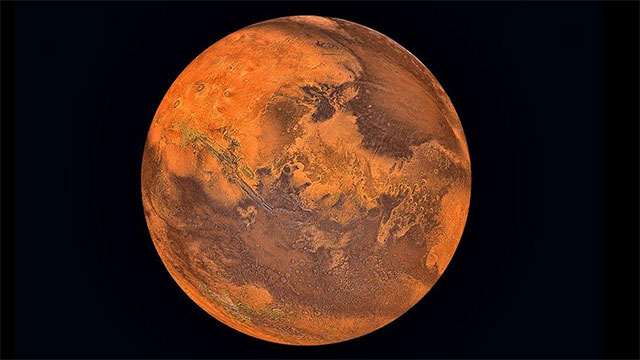Scientists explain why Mars has a red surface
For centuries, scientists have wondered why Mars is red. The long-standing theory is that the planet's rusty hue comes from hematite, an iron-rich mineral that forms in arid conditions. But new research suggests that another factor may be responsible: ferrihydrite, an iron oxide-hydroxide mineral that forms in wet environments.
The study, published in the journal Nature Communications and conducted by scientists from Brown University and the University of Bern in Switzerland, found that ferrihydrite (Fe5O8H · nH2O) is the predominant iron-containing mineral in Martian dust. Their findings — based on orbital observations, rover data, and laboratory experiments — challenge previous ideas about the composition of the Martian surface.
' The fundamental question of why Mars is red has been asked for hundreds if not thousands of years ,' said Dr Adomas Valantinas. ' From extensive analysis, we believe that ferrihydrite is ubiquitous in the dust and perhaps also in the rock formations .'
Ferrihydrite forms when iron reacts with oxygen and water. On Earth, the element is commonly found in rocks and volcanic ash. The presence of ferrihydrite on Mars suggests that the planet was once much wetter, with conditions that could support liquid water. This is in contrast to hematite, which forms in drier environments.

To test their hypothesis, the researchers recreated Martian conditions in the lab. They crushed the mineral into tiny particles—about 1/100th the width of a human hair—that are roughly the size of actual Martian dust. They then studied how light reflected off these particles. The results showed that ferrihydrite is stable in Mars' current cold, dry climate, but its structure still retains signs of forming when the planet had water.
' This study shows evidence that ferrihydrite formed, and for that to happen, conditions had to be present where oxygen and water could react with the iron, ' Valantinas explains. ' Those conditions were very different from today's cold, dry environments. '
To confirm the presence of ferrihydrite, the team analyzed data from NASA's Mars Reconnaissance Orbiter (MRO) and the ESA's (European Space Agency) Mars Express and Trace Gas Orbiter. They also used spectroscopic data from the Curiosity, Pathfinder, and Opportunity rovers. Combining all the data sources, the scientists found that the mineral appears to be widely distributed across the Martian surface.
This discovery challenges previous theories that suggested Mars gradually oxidized under dry conditions. Instead, it suggests that ancient Mars went through a wetter phase before drying out. The transition from its water-rich past to the dry, dusty planet we see today is key to understanding Mars' climate history—and perhaps even its ability to support life.
While the findings provide strong evidence for the role of ferrihydrite in Mars' red dust, definitive proof will have to wait until samples from Mars — currently being collected by NASA's Perseverance rover — are brought back to Earth. Scientists hope these samples will confirm the hypothesis and shed more light on the Red Planet's environmental history.
You should read it
- Why are microorganisms living 'so tough' on Earth but still hard to survive on Mars
- 5 most interesting findings about Red Planet
- Please admire the 2.5 billion pixel image capturing detailed panoramic views of Mars
- Mars: Overview of the 4th planet in the solar system
- Looking back at NASA's Mars exploration process over the past 20 years
- NASA rover shares stunning images of Mars' moon Deimos
 Admire the rare brilliant light show on Jupiter
Admire the rare brilliant light show on Jupiter The moment a wandering black hole 'swallows' a star
The moment a wandering black hole 'swallows' a star See the 'cosmic masterpiece' created by a star nearing the end of its life
See the 'cosmic masterpiece' created by a star nearing the end of its life James Webb telescope captures stunning cosmic hourglass moment
James Webb telescope captures stunning cosmic hourglass moment Object from unknown location continuously emitting radio waves
Object from unknown location continuously emitting radio waves Smallest galaxy ever discovered: Like a human but only the size of a grain of rice
Smallest galaxy ever discovered: Like a human but only the size of a grain of rice